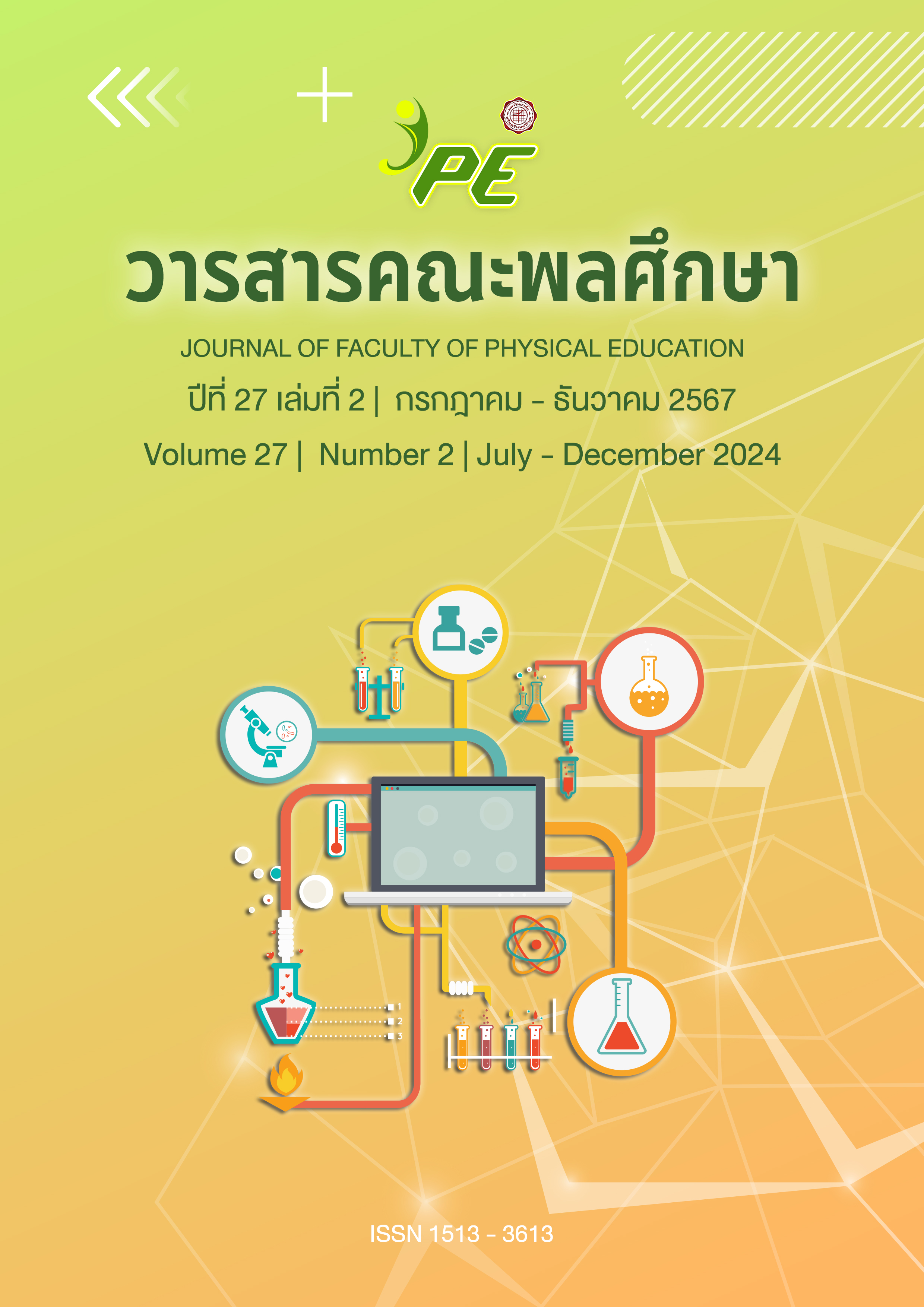การพัฒนาโปรแกรมการออกกำลังกายวิถีใหม่เพื่อพัฒนาสมรรถภาพทางกาย ที่สัมพันธ์กับสุขภาพสำหรับนักศึกษาระดับอุดมศึกษา
Main Article Content
บทคัดย่อ
การวิจัยนี้มีวัตถุประสงค์เพื่อ 1) เพื่อพัฒนาโปรแกรมการออกกำลังกายวิถีใหม่เพื่อพัฒนาสมรรถภาพทางกายที่สัมพันธ์กับสุขภาพสำหรับนักศึกษาระดับอุดมศึกษา 2) เพื่อศึกษาผลของโปรแกรมการออกกำลังกายวิถีใหม่เพื่อพัฒนาสมรรถภาพทางกายที่สัมพันธ์กับสุขภาพสำหรับนักศึกษาระดับอุดมศึกษา วิธีดำเนินการวิจัยแบ่งเป็น 4 ระยะ ได้แก่ 1) ศึกษาสภาพปัญหาและความต้องการโปรแกรมฯ 2) พัฒนาโปแกรมฯ 3) ทดลองใช้โปรแกรมฯ 4) ประเมินและสรุปผลการใช้โปรแกรมฯ กลุ่มตัวอย่าง คือ นักศึกษาระดับอุดมศึกษาจำนวน 60 คน ได้จากการสุ่มอย่างง่าย (Simple Random Sampling) ในการคัดเลือกเป็นกลุ่มทดลอง จำนวน 30 คน และกลุ่มควบคุม จำนวน 30 คน ดำเนินกิจกรรมเป็นระยะเวลา 8 สัปดาห์ สัปดาห์ละ 5 หรือ 7 วัน เครื่องมือที่ใช้ประกอบด้วย 1) โปรแกรมการออกกำลังกายฯ 2) แบบทดสอบสมรรถภาพทางกายที่สัมพันธ์กับสุขภาพ วิเคราะห์ข้อมูลด้วยการวิเคราะห์ค่าเฉลี่ย ส่วนเบี่ยงเบนมาตรฐาน และการทดสอบค่าที ที่ระดับนัยสำคัญทางสถิติที่ระดับ .05
ผลการวิจัยพบว่า
1) โปรแกรมการออกกำลังกายฯ มีค่าดัชนีของความสอดคล้อง (IOC) เท่ากับ 0.94 ประกอบด้วย 1.1) ความถี่ในการออกกำลังกายสัปดาห์ละ 5 หรือ 7 วัน 1.2) ความหนักในการออกกำลังกายใช้ระดับปานกลางถึงหนัก 1.3) ระยะเวลาที่ใช้ในการออกกำลังกายไม่เกิน 60 นาทีต่อวัน 1.4) ชนิดของการออกกำลังกาย แบ่งเป็น 3 ชนิด ได้แก่ 1.4.1) การคาร์ดิโอ 8 กิจกรรม 1.4.2) การยืดเหยียดกล้ามเนื้อ 6 ท่า และ 1.4.3) การฝึกแบบแรงต้านโดยใช้น้ำหนักของร่างกาย 7 ท่า 1.5) ขั้นตอนการออกกำลังกาย แบ่งเป็น 5 ขั้นตอน คือ ขั้นอบอุ่นร่างกาย ขั้นยืดเหยียดกล้ามเนื้อแบบเคลื่อนไหว ขั้นออกกำลังกาย ขั้นคลายอุ่น ขั้นยืดเหยียดกล้ามเนื้อแบบหยุดนิ่ง
2) ผลการออกกำลังกายฯ พบว่า ภายหลังการทดลอง กลุ่มทดลองมีสมรรถภาพทางกายที่สัมพันธ์กับสุขภาพในด้านความอดทนของระบบไหลเวียนโลหิตและระบบหายใจ ด้านความแข็งแรงอดทนของกล้ามเนื้อ และด้านความอ่อนตัว ดีกว่าก่อนการทดลองอย่างมีนัยสำคัญทางสถิติที่ระดับ .05
Article Details

This work is licensed under a Creative Commons Attribution-NonCommercial-NoDerivatives 4.0 International License.
บทความและข้อคิดเห็นใดๆ ในวารสาร เป็นทัศนะของผู้เขียน คณะพลศึกษาไม่จำเป็นต้องเห็นชอบด้วยเสมอไปผู้ใดประสงค์จะนำข้อความไปตีพิมพ์หรือเผยแพร่ต้องได้รับอนุญาตจากผู้เขียนโดยตรง
References
Bangkok Business. (2020). What does ‘Pandemic’ mean? What happens after the WHO elevates the level of
COVID-19?. Retrieved from https://www.bangkokbiznews.com/news/detail/870455
Bumrungrad International Hospital. (2016). Non-communicable diseases (NCDs)… diseases caused by behavior.
Retrievedfromhttps://www.bumrungrad.com/th/health-blog/may-2016/ncds-non-communicable-diseasessymptoms-
prevention
Charoen, K. (2009). Muscle stretching. Faculty of Education, Kasetsart University.
Charoen, K. (2014). Science of coaching (1st ed.). Sinthana Copy Center Co., Ltd.
Department of Physical Education. Physical fitness tests and norm for people aged 19-59 years. [online] 2021
Available from: https://www.dpe.go.th/manual-preview-411291791796 [2021, April 20]
Haff, G. G., & Triplett, N. T. (2016). Essentials of strength training and conditioning (4th ed.). Human Kinetics.
Manoch, B. (2018). License C training manual
Nirut, S., Sutthana, T., & Ratchanee, K. (2019). Development of exercise program using sensory integration
theory with Thai wisdom to improve health-related physical fitness and social skills of autistic children.
Chulalongkorn University Journal of Education, 47(Supplement 2), 150-168.
Sanook. (2020). Exercise in the new normal: Staying safe from COVID-19. Retrieved from
https://www.sanook.com/health/24645/
Suriyan, S. (2017). A guide for physical activity development for developing physical literacy for prathomsuksa 3
students. (Doctoral dissertation, Kasetsart University).
Thai Health Promotion Foundation. (2020). Thai health watch 2021.
Thailand Knowledge Center for Physical Activity. (2020). Home physical activity guide (1st ed.). Sahamit Printing
and Publishing Co., Ltd.
Thanomwong, K. (2012). Exercise physiology (2nd ed.). Teeranasarn.
topendsports. All Fitness Tests. [online] 2021 Available from:
https://www.topendsports.com/testing/tests.htm [2021, April 20]
VOICEonline. (2020). The Royal Society defines “new normal” as a new way of life, while “new norm” as a new
standard. Retrieved from https://voicetv.co.th/read/gEEgnvbnX
Wisit, K. (2011). Organization and management of physical education. Nam Kang Printing.

